1993 CHEVROLET SUBURBAN four wheel drive
[x] Cancel search: four wheel drivePage 238 of 386
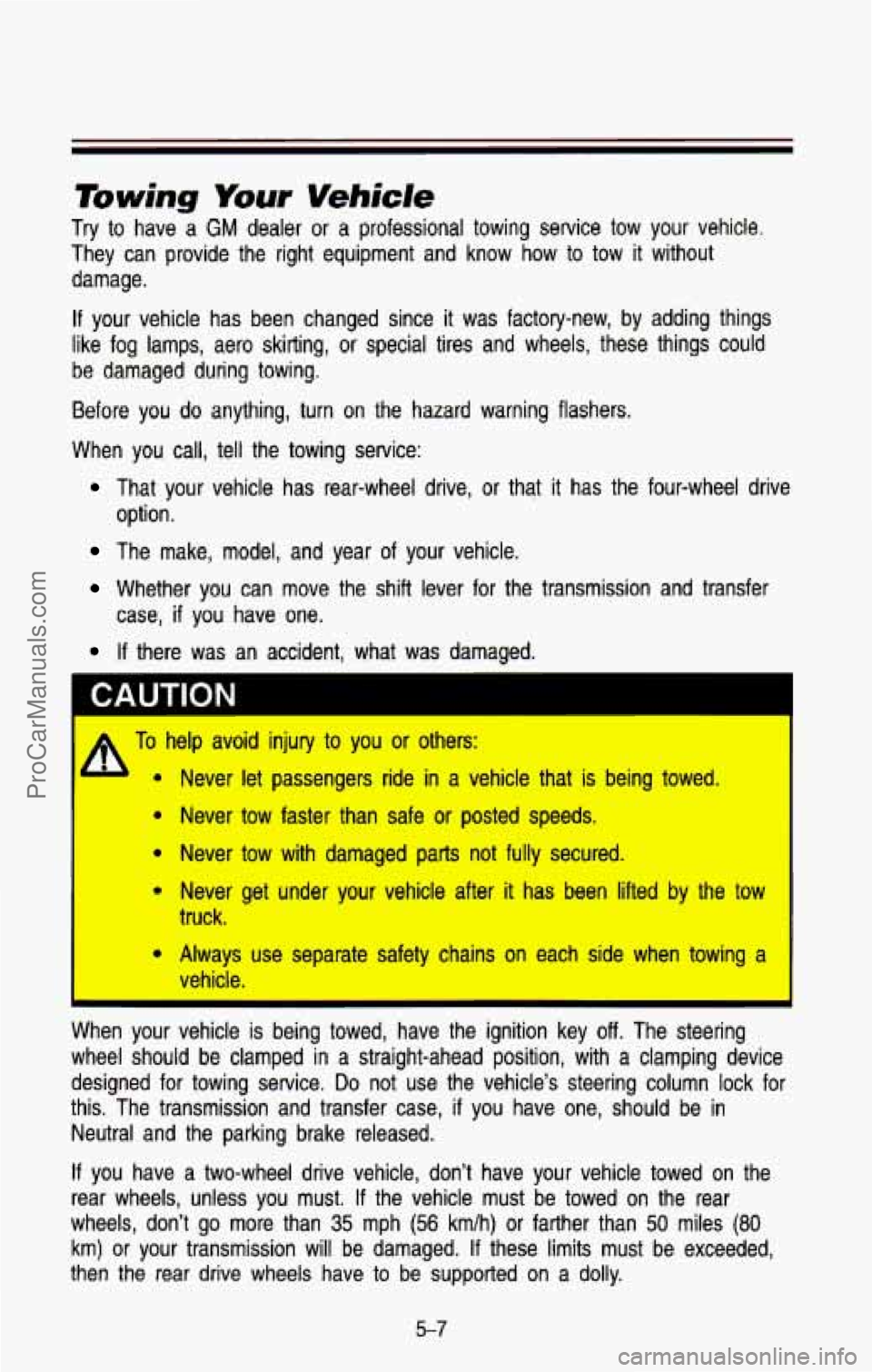
Tiwing Your Vehicle
Try to have a GM dealer or a professional towing service tow your vehicle.
They can provide the right equipment and know how to tow
it without
damage.
If your vehicle has been changed since it was factory-new, by adding things
like fog lamps, aero skirting,
or special tires and wheels, these things could
be damaged during towing.
Before you
do anything, turn on the hazard warning flashers.
When you call, tell the towing service:
That your vehicle has rear-wheel drive, or that it has the four-wheel drive
option.
The make, model, and year of your vehicle.
Whether you can move the shift lever for the transmission and \
transfer
If there was an accident, what was damaged.
case,
if you have one.
CAUTION I
To help avoid
injury to you or others:
A 9 Never let passengers ride in a vehicle that is being towed.
e Never tow faster than safe or posted speeds.
e Never tow with damaged parts not fully secured.
Never get under your vehicle after it has been lifted by the tow
truck.
* Always use separate safety chains on each side when towing a
vehicle.
When your vehicle is being towed, have the ignition key off. The steering
wheel should be clamped in a straight-ahead position, with a clamping device
designed for towing service.
Do not use the vehicle’s steering column lock for
this. The transmission and transfer case,
if you have one, should be in
Neutral and the parking brake released.
If you have a two-wheel drive vehicle, don’t have your vehicle \
towed on the
rear wheels, unless you must.
If the vehicle must be towed on the rear
wheels, don’t
go more than 35 mph (56 kmlh) or farther than 50 miles (80
km) or your transmission will be damaged. If these limits must be exceeded,
then the rear drive wheels have to be supported on a dolly.
5-7
ProCarManuals.com
Page 239 of 386
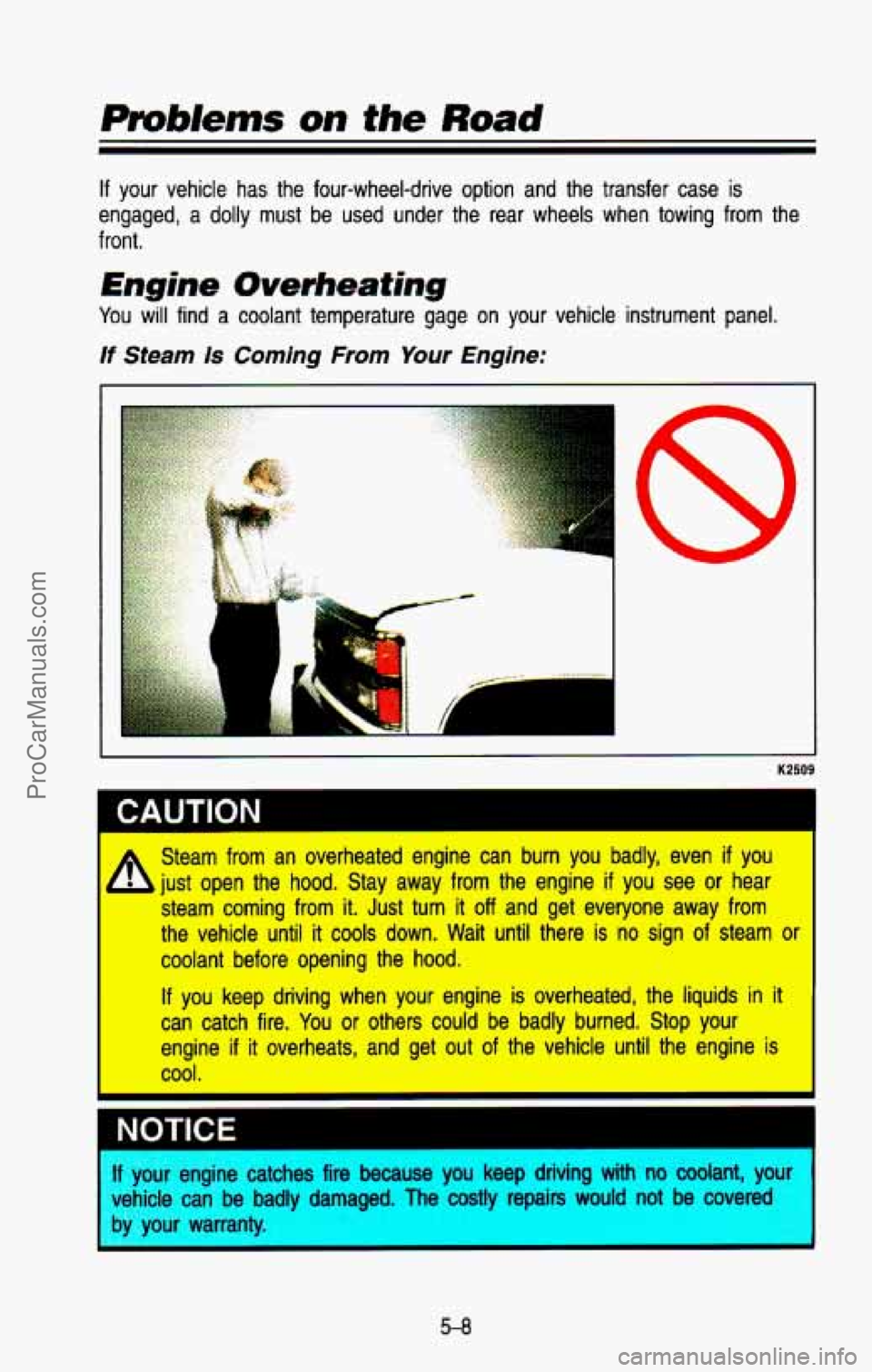
Pmbkms on the Road
If your vehicle has the four-wheel-drive option and the transfer case is
engaged,
a dolly must be used under the rear wheels when towing from the
front.
Engine Overheating
You will find a coolant temperature gage on your vehicle instrument panel,
If Steam Is Coming From Your Engine:
I
‘i Steam from an overheated engine can bum you badly, even if you
just open the hood. Stay away from the engine if you see or hear
steam coming from it. Just turn it off and get everyone away from
the vehide until it cools down. Wait until there is no sign of steam or
coalant before opening the hood.
If you keep driving when your engine is overheated, the liquids in it
can catch fire. You or others could be badly burned. Stop your
engine if it overheats, and get out of the vehicle until the engine is
Cool.
you keep driving with no coolant, your
costly repairs would not be covered
by
your warranty.
5-8
ProCarManuals.com
Page 248 of 386
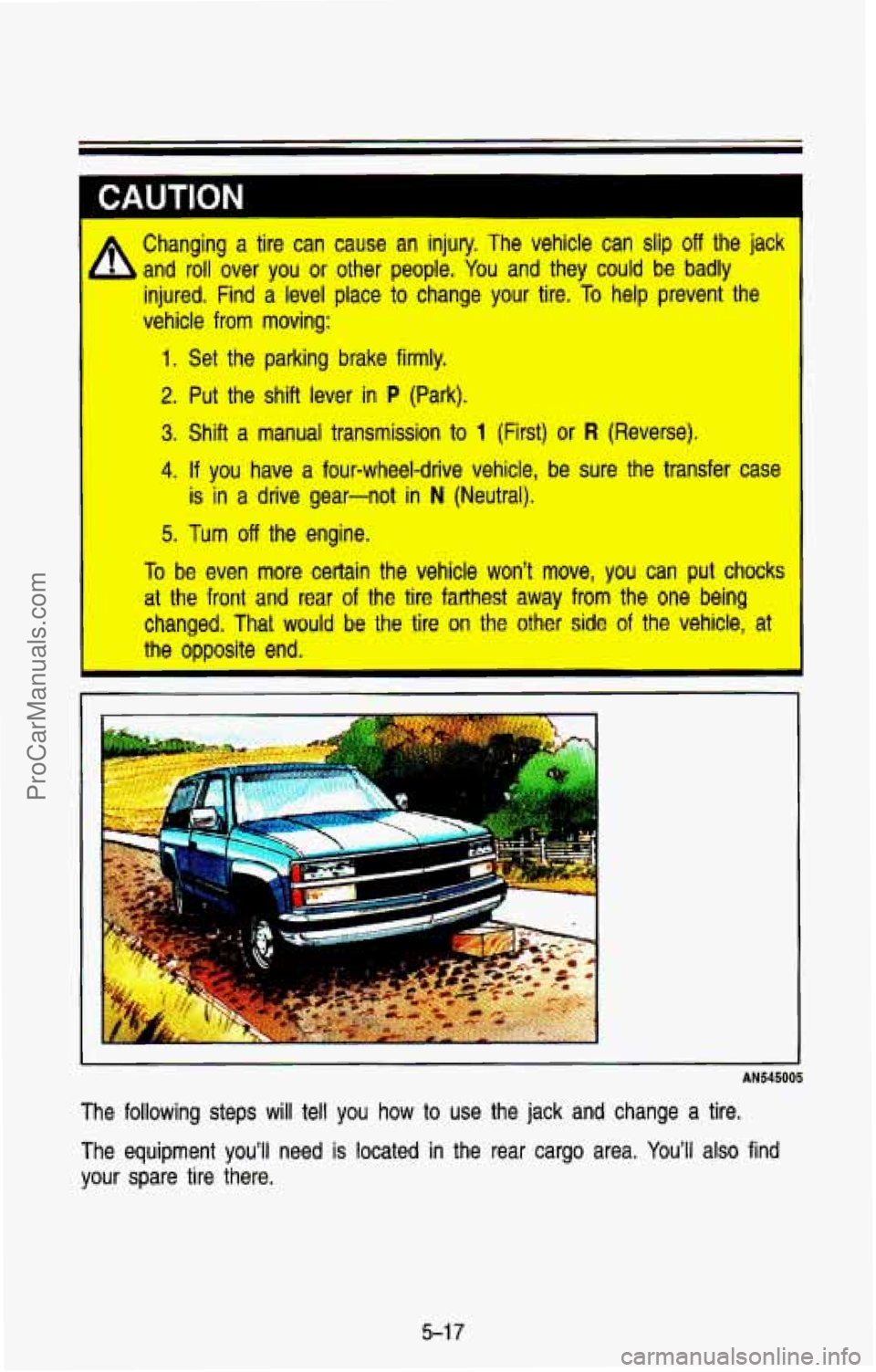
L
Changing a tire can cause an injury. The vehicle can slip off the jack
injured. Find a level place to change your tire. To help prevent the
vehicle
from moving:
- and roll over you or other people. You and they could be badly
1. Set the parking brake firmly.
2. Put the shift lever in P (Park).
3. Shift a manual transmission to 1 (First) or R (Reverse).
4. If you have a four-wheel-drive vehicle, be sure the transfer case \
5. Turn off the engine.
is in a drive gear-not in N (Neutral).
To be even more certain the vehicle won't move, you can put chocks
at the front and rear of the tire farthest away from the one being
changed. That would be the tire on the other side of the vehicle, at
the opposite end.
I
L
I
The following steps will tell you how to use the jack and change a tire.
5-1 7
ProCarManuals.com
Page 288 of 386
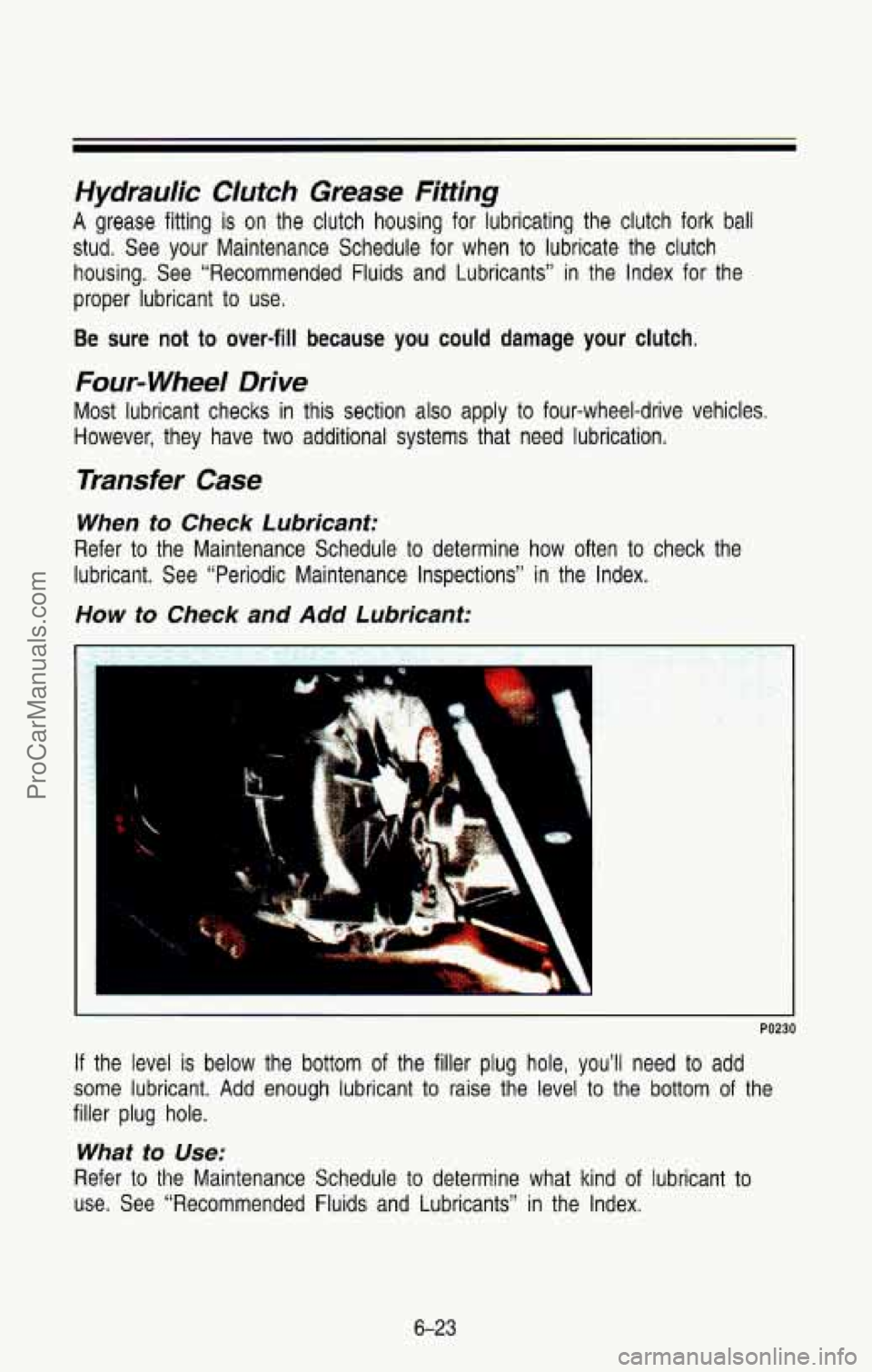
Hydraulic Clufch Grease Fittrhg
A grease fitting is on the clutch housing for lubricating the clutch fork ball
stud. See your Maintenance Schedule for when to lubricate the clutch
housing. See “Recommended Fluids and Lubricants” in the In\
dex for the
proper lubricant to use.
Be sure not to over-fill because you could damage your clutch.
Four- Wheel Drive
Most lubricant checks in this section also apply to four-wheel-drive vehicles.
However, they have
two additional systems that need lubrication.
Transfer Case
When to Check Lubricant:
Refer to the Maintenance Schedule to determine how often to check the
lubricant. See “Periodic Maintenance Inspections” in the In\
dex.
How to Check and Add Lubricant:
d Ti
I
PO230
If the level is below the bottom of the filler plug hole, you’ll need to add
some lubricant. Add enough lubricant to raise the level
to the bottom of the
filler plug hole.
What to Use:
Refer to the Maintenance Schedule to determine what kind of lubricant to
use. See “Recommended Fluids and Lubricants” in the Index.\
6-23
ProCarManuals.com
Page 335 of 386

Fuses and Circuit Breakers
Name
Gages
Turn-BIU EMCIIgn
Inj.
A
Brake
AC/Htr
ctsy
Park LP
P. Lps
StopiHaz.
Wiper Radio
Acc/lgn.
AcdBatt. Crank 4WD
DRL
RR Wpr
TIG Re1
Circuits Protected
Cruise Control, 4 WD Display Illum. Rear
Window Defogger Timer, Aux. Batt. Relay Feed, Safety Belt Buzzer Timer, Cluster
Ign. Feed
Back-up Lamps, Turn Signals
T.C.C., Air Diverter, E.S.C.,
E.G.R., E.C.M.
Ign., R.W.A.L. Brake Switch
Throttle Body Injectors
A.B.S., Cluster-Speed0
H.V.A.C.
4 WD, Aux. Batt. Relay
Dome Lamp, Ctsy. and Glove Box Lps.
(TR-9), Radio (Memory-Clock)
Horn Relay, Horn Feed, Park Lamps C49 SW Illum., Headlamp
“On” Warning,
Radio Illum., H.V.A.C. Illum.
Haz. Flasher, Seat Belt Buzzer, Stop
Lmps., A.B.S. Memory
Windshield Wiper, Washer
Radio Feed
Pwr. Windows
Door Locks, Rear Window Defogger Crank, Discreet
Four Wheel Drive
Daytime Running Lights
Rear Window Wiperwasher
Cigar Lighter, Rear Hatch Release
Fuse
20 Amp
15 Amp
10 Amp
10 Amp
15 Amp
25
Amp
20 Amp
20 Amp
5 Amp
15 Amp
25 Amp
10 Amp
5 Amp
25 Amp
15 Amp
25 Amp
25 Amp
Circuit
Breaker
30 Amp
30 Amp
An inline fuse is used for the underhood lamp
Jo not use fuses of higher amperage than those recommended above.
TO291
6-70
ProCarManuals.com
Page 337 of 386
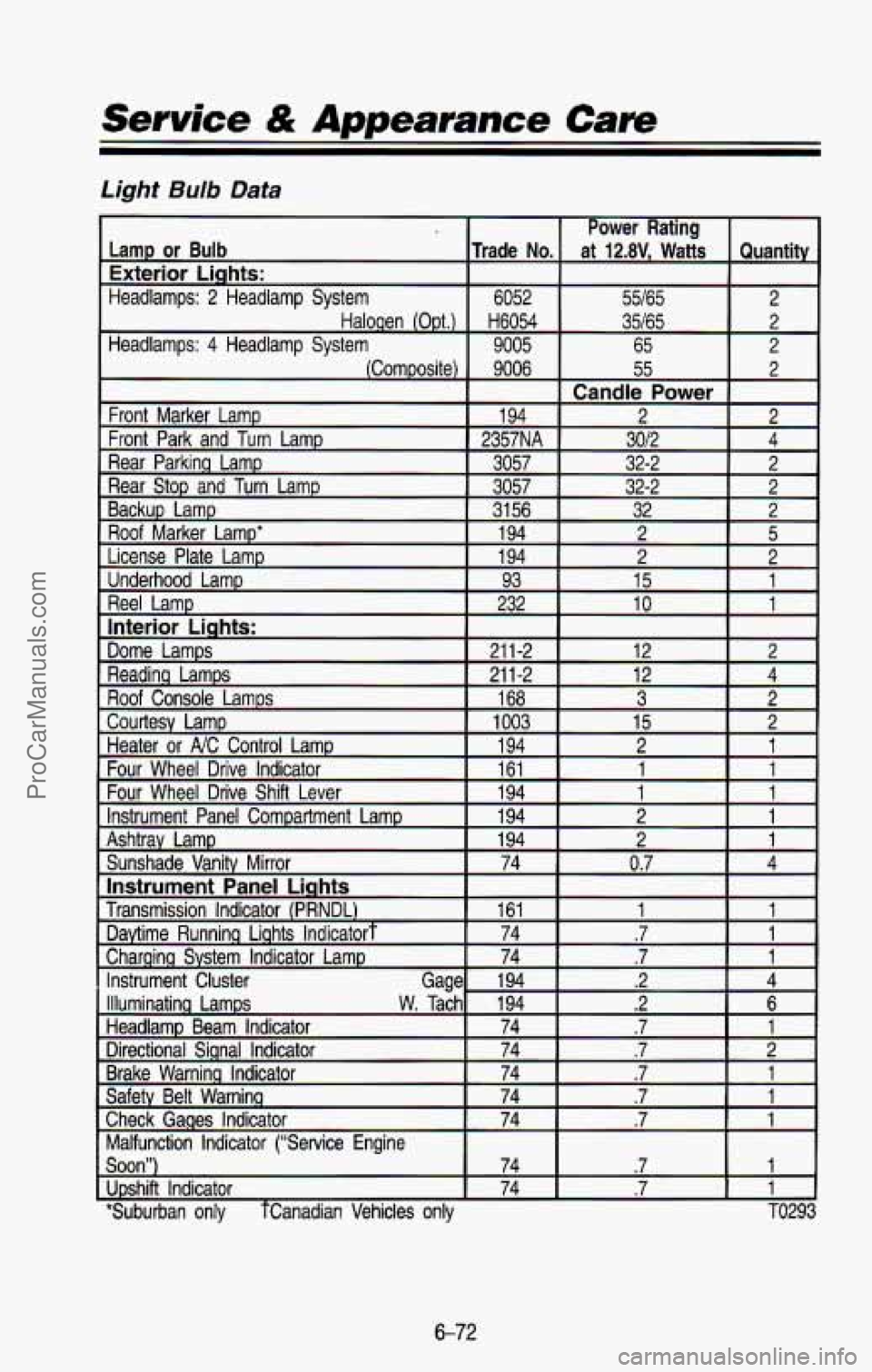
Service & Appearance Care
Light Bulb Data
Lamp or Bulb
6052
Headlamps: 2 Headlamp System
Exterior Liqhts:
Trade No.
Haloaen (Opt.) H6054
Headlamps: 4 Headlamp System
9005
(Composite) 9006
Interior Lights:
Dome Lamps 21
1-2
I Readina Lamps I 211-2
Roof Console Lamps
1 94
Instrument Panel Compartment Lamp 1
94
Four Wheel Drive Shift Lever 161
Four Wheel Drive Indicator 194
, Heater or
NC Control Lamp 1003
, Courtesy Lamp
168
1 Ashtray Lamp I 194
Malfunction Indicator (“Service Engine
-
Soon”)
*Suburban only tCanadian Vehicles only
74
Upshift Indicator 74
Power Rating
55/65 121
35/65
2
65
2
1 Candle Power
,,.,I
32-2
11
10
12 2
XI
TO293
6-72
ProCarManuals.com
Page 341 of 386
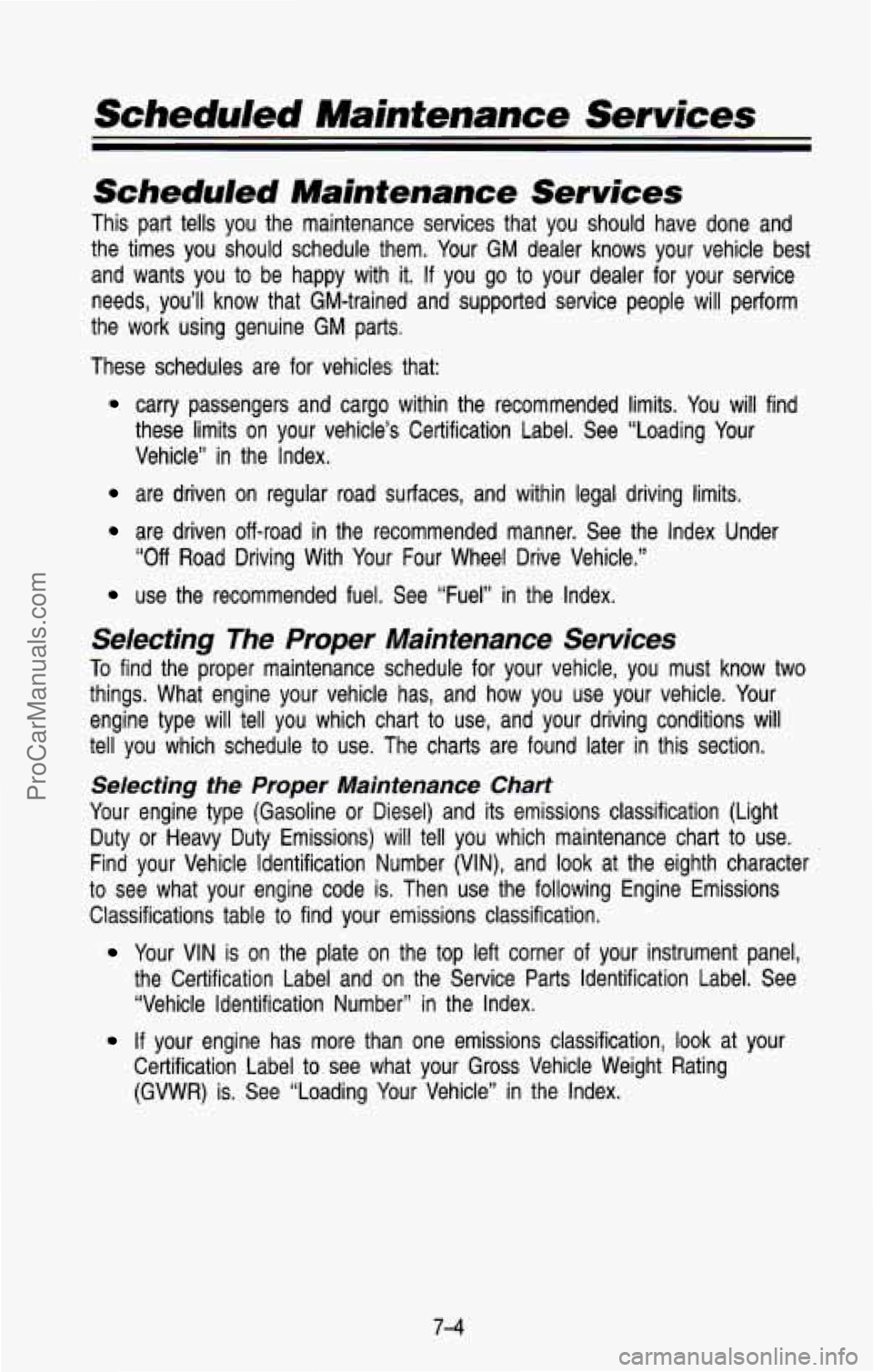
Scheduled Maintenance Services
Scheduled Maintenance Services
This part tells you the maintenance services that you should h\
ave done and
the times you should schedule them. Your
GM dealer knows your vehicle best
and wants you to be happy with it.
If you go to your dealer for your service
needs, you’ll know that GM-trained and supported service peop\
le will perform
the work using genuine GM parts.
These schedules are for vehicles that:
carry passengers and cargo within the recommended limits. You will find
these limits on your vehicle’s Certification Label. See “L\
oading Your
Vehicle” in the Index.
are driven on regular road surfaces, and within legal driving \
limits.
are driven off-road in the recommended manner. See the index Under
use the recommended fuel. See “Fuel” in the Index.
“Off Road Driving With Your Four Wheel Drive Vehicle.”
Selecting The Proper Maintenance Services
To find the proper maintenance schedule for your vehicle, you must know\
two
things. What engine your vehicle has, and how you use your ve\
hicle. Your
engine type will tell you which chart to use, and your driving conditions will
tell you which schedule to use. The charts are found later in this section.
Selecting the Proper Maintenance Chart
Your engine type (Gasoline or Diesel) and its emissions classification (L\
ight
Duty
or Heavy Duty Emissions) will tell you which maintenance chart to use.
Find your Vehicle Identification Number (VIN), and
look at the eighth character
to see what your engine code is. Then use the following Engine Emissions
Classifications table
to find your emissions classification.
Your VIN is on the plate on the top left corner of your instrument panel,
the Certification Label and on the Service Parts Identification Label. See
“Vehicle Identification Number” in the Index.
Certification Label to see what your Gross Vehicle Weight Rating
(GVWR) is. See “Loading Your Vehicle” in the Index.
If your engine has more than one emissions classification, look at your
7-4
ProCarManuals.com
Page 361 of 386
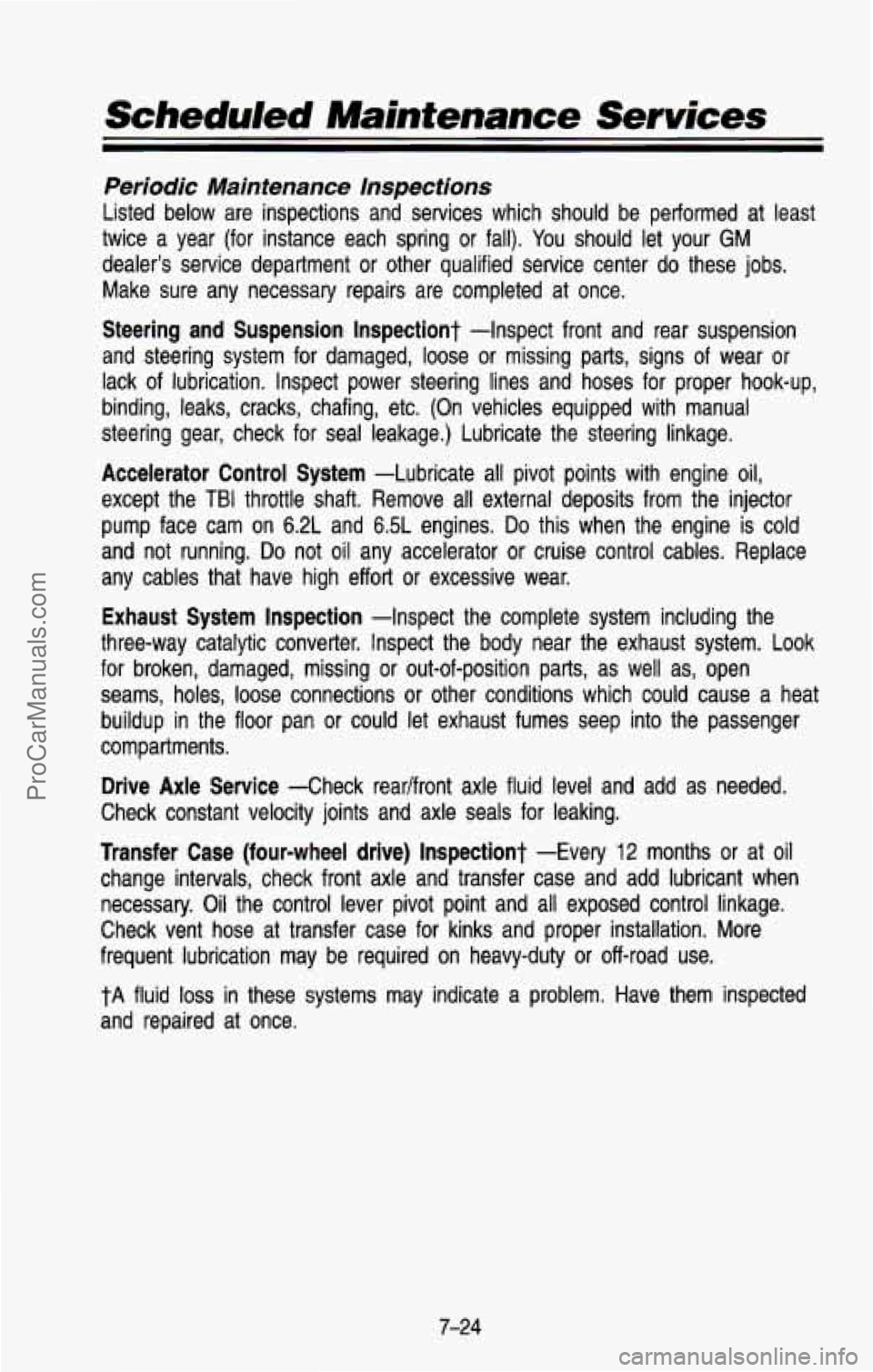
Scheduled Maintenance Services
Periodic Maintenance Inspections
Listed below are inspections and services which should be performed at least
twice a year (for instance each spring or fall). You should let your GM
dealer’s service department or other qualified service center
do these jobs.
Make sure any necessary repairs are completed at once.
Steering and Suspension lnspectiont -Inspect front and rear suspension
and steering system
for damaged, loose or missing parts, signs of wear or
lack of lubrication. Inspect power steering lines and hoses for\
proper hook-up,
binding, leaks, cracks, chafing, etc. (On vehicles equipped wit\
h manual
steering gear, check for seal leakage.) Lubricate the steering linkage.
Accelerator Control System -Lubricate all pivot points with engine oil,
except the
TBI throttle shaft. Remove all external deposits from the injector
pump face cam on 6.2L and 6.5L engines.
Do this when the engine is cold
and not running.
Do not oil any accelerator or cruise control cables. Replace
any cables that have high effort
or excessive wear.
Exhaust System Inspection -Inspect the complete system including the
three-way catalytic converter. Inspect the body near the exhaust system. Look
for broken, damaged, missing
or out-of-position parts, as well as, open
seams, holes, loose connections
or other conditions which could cause a heat
buildup in the
floor pan or could let exhaust fumes seep into the passenger
compartments.
Drive Axle Service -Check readfront axle fluid level and add as needed.
Check constant velocity joints and axle seals for leaking.
Transfer Case (four-wheel drive) lnspectiont -Every 12 months or at oil
change intervals, check front axle and transfer case and add l\
ubricant when
necessary. Oil the control lever pivot point and all exposed control linkage. \
Check vent hose at transfer case for kinks and proper installa\
tion. More
frequent lubrication may be required on heavy-duty
or off-road use.
tA fluid loss in these systems may indicate a problem. Have them inspected
and repaired at once.
7-24
ProCarManuals.com